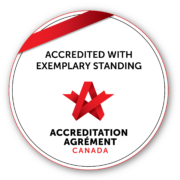Have you been exposed to COVID?
What is a COVID exposure?
Close contact with a COVID positive individual happens when you are within 6 feet of someone for a cumulative total of 15 minutes or more over a 24-hour period.
Assess if you have been exposed:
Have you been within 6 feet of someone who is COVID positive for 15 minutes?
The individual likely had no symptoms at the time you were exposed.
In the apartments, this exposure is most likely to happen when visiting without masks in an apartment suite or while eating (without masks) in the dining room or elsewhere.
In the community, this exposure is most likely to happen when visiting without a mask, attending a gathering without a mask or driving with someone without a mask on.
Should you consider yourself exposed to COVID even if you were wearing a mask during this exposure?
Yes, this is a way to protect your loved ones and neighbours.
Take a rapid test
- Take a rapid test. If the rapid test is positive, consider yourself COVID POSITIVE and follow these directions – CLICK HERE
- If the rapid test is negative, self-isolate and self-monitor for FIVE days.
- If you have the onset of COVID symptoms, take another rapid test or get a PCR test at the Haida Testing Center. If the test is COVID POSITIVE, follow these directions – CLICK HERE
What does it mean to self-isolate?
Stay home. Do not go out to public places. Do not leave your apartment – not for laundry or groceries.
Have family, friends or a delivery service bring you food, groceries, medicines and other supplies.
Do not have visitors inside unless they are homecare providers or providing essential care.
What does it mean to self-monitor?
Rapid Test is POSITIVE
A positive rapid test is considered to be accurate. You are COVID positive.
How to do a rapid test – CLICK HERE
What does a positive rapid test look like? CLICK HERE
Let Menno Place know that you tested positive – call 604.835.9504
Rapid Test is NEGATIVE
A negative rapid test is not a DEFINITIVE negative. You can test negative if you don’t have enough viral load for a positive result.
- Remain on self-isolation for five days. What is self-isolation? CLICK HERE
- Self-monitor for COVID symptoms. COVID Symptom Self-Checker – CLICK HERE
- If you become symptomatic, repeat the rapid test.
What are COVID symptoms?
People with COVID-19 have had a wide range of symptoms reported – ranging from mild symptoms to severe illness. Symptoms may appear 2-14 days after exposure to the virus. Symptoms may include:
- Fever or chills
- Cough
- Shortness of breath or difficulty breathing
- Fatigue
- Muscle or body aches
- Headache
- New loss of taste or smell
- Sore throat
- Congestion or runny nose
- Nausea or vomiting
- Diarrhea
How to self-monitor
- Watch closely for symptoms of COVID-19, even mild ones.
- You can use the Daily Self-Monitoring Form for COVID-19 to keep track of symptoms.
- Record your temperature every day.
- Taking medicine that reduces fever (e.g. Tylenol, Advil) may hide symptoms so avoid taking them if possible.
- If you get symptoms, self-isolate right away and check our testing page to see if you need to get tested.
Keeping others safe while self-isolating:
If you travel in a car with anyone, including someone from your own household:
- Everyone must wear a mask
- Roll down all the windows
- Everyone should clean their hands before and after the ride
If you live with another person in your suite:
- If possible, stay 6 feet apart in the apartment
- Everyone should wear a mask that covers nose and mouth and goes under the chin
- Open windows to increase airflow
- If your mask gets damaged or dirty, remove it, wash hands and put a new one on. Medical masks are available in the foyer.
- Eat by yourself.
- Everyone should wash hands often with soap and water, or use hand sanitizer.
- Cough or sneeze into a tissue. If you don’t have a tissue, use your sleeve, not your hand.
- Throw tissues out into a separate garbage bag, close it and throw it in the garbage.
If you share a bathroom:
- Put down the toilet seat before you flush
- Turn on the fan or open the window
- Clean handles nad faucets after each use
- Avoid sharing personal items like toothbrushes and towels
- Clean and disinfect high-touch surfaces such as door handles, light switches, faucets, phones, computers and remote controls. Use a household disinfectant or diluted bleach (4 teasponons/20ml in 1 litre of water).




